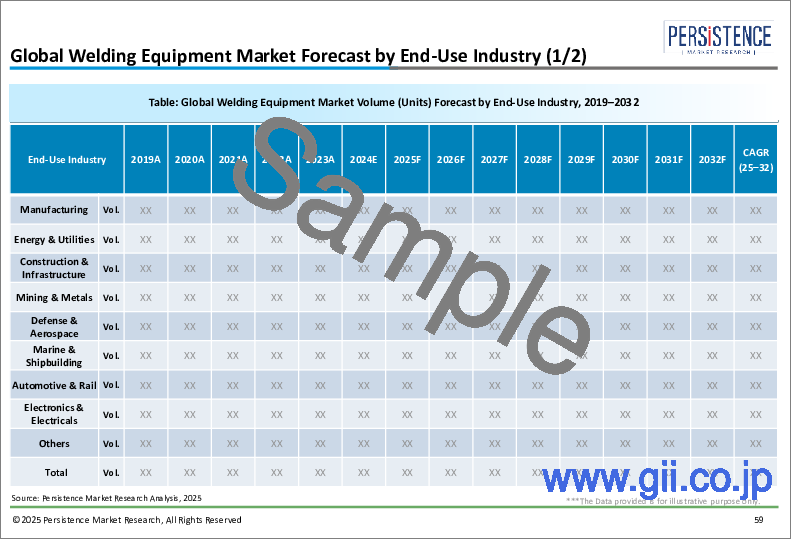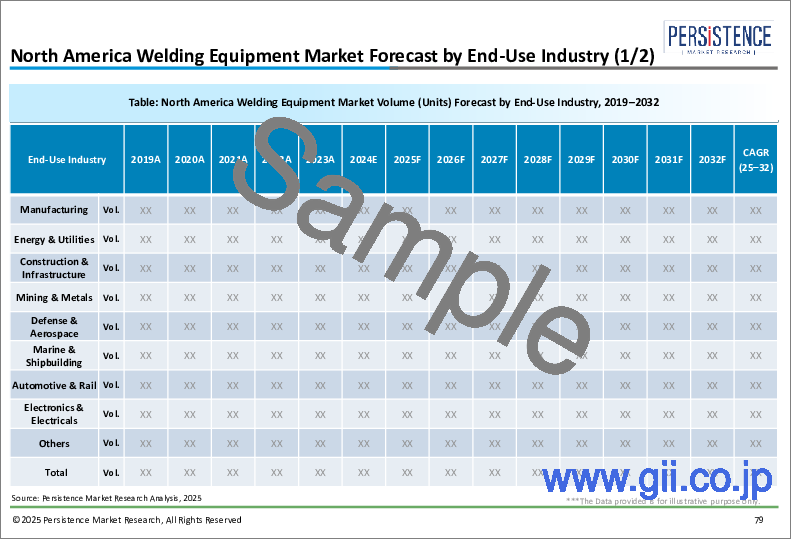|
|
市場調査レポート
商品コード
1622877
溶接機の世界市場:産業分析、規模、シェア、成長、動向、予測(2024年~2031年)Welding Equipment Market: Global Industry Analysis, Size, Share, Growth, Trends, and Forecast, 2024-2031 |
||||||
カスタマイズ可能
|
|||||||
| 溶接機の世界市場:産業分析、規模、シェア、成長、動向、予測(2024年~2031年) |
|
出版日: 2024年12月25日
発行: Persistence Market Research
ページ情報: 英文 246 Pages
納期: 2~5営業日
|
全表示
- 概要
- 目次
重要考察
- 溶接機の市場規模:182億米ドル(2024年)
- 予測される市場金額:286億米ドル(2031年)
- 世界市場の成長率:5.8%(2024年~2031年のCAGR)
溶接機市場 - レポート範囲
溶接機市場には、金属や熱可塑性材料の接合用に設計されたさまざまなツールや機械が含まれます。これらの製品には、アーク溶接機、抵抗溶接機、レーザー溶接機などが含まれ、建設、自動車、造船、航空宇宙などの多様な産業に対応しています。市場は、工業メーカー、請負業者、DIY消費者など、幅広いエンドユーザーにサービスを提供しています。効率的で耐久性のある溶接ソリューションに対する需要の高まり、自動化の進行、産業用途におけるロボット溶接システムのような革新的技術の採用の拡大が成長の促進要因となっています。
市場成長の促進要因
複数の主な要因が世界の溶接機市場を牽引しています。新興経済国を中心としたインフラ開発への需要の増加が市場の成長を大きく後押ししています。ハイブリッド溶接システムやインダストリー4.0統合などの技術の進歩が生産性と精度を高め、市場拡大に拍車をかけています。さらに、再生可能エネルギープロジェクトへの注目の高まりと、それに伴う特殊な溶接機へのニーズが、市場の成長に寄与しています。研究開発活動の強化と、自動車や航空宇宙用途での軽量材料の採用の増加は、先進の溶接技術への需要をさらに促進しています。
市場抑制要因
有望な成長見通しにもかかわらず、溶接機市場は先進の溶接システムの高い初期費用や熟練溶接工の不足に関連する課題に直面しています。自動化やロボット溶接技術には多額の投資が必要であり、中小企業には手が出ない可能性があるため、市場成長が妨げられる可能性があります。さらに、溶接工程での排出やエネルギー消費に関する環境問題が、市場参入企業に課題を突きつけています。こうした問題に対処するには、エネルギー効率の高いソリューションの革新、環境規制の遵守、技能開発プログラムの重点化などが必要です。
市場機会
市場は、製造における自動化の採用の高まりと、カスタマイズされた溶接ソリューションに対する需要の増加により、大きな機会をもたらしています。軽量で持ち運び可能な溶接機の開発は、建設・修理産業のニーズの高まりに対応しています。さらに、摩擦攪拌接合や積層造形などの溶接技術の進歩が市場成長への道を開きます。電気自動車(EV)市場の拡大と再生可能エネルギープロジェクトは、溶接機メーカーに特殊ツールを供給する新たな機会を提供します。戦略的パートナーシップ、グリーン溶接技術への投資、ユーザーフレンドリーな機械の導入は、新たな機会を生かし、市場でのリーダーシップを維持するのに不可欠です。
当レポートでは、世界の溶接機市場について調査分析し、成長促進要因、動向、機会、課題などの市場力学の詳細な分析を提供しています。
目次
第1章 エグゼクティブサマリー
第2章 市場のイントロダクション
第3章 溶接機市場の分析シナリオ
- 市場数量の分析
- 価格分析
- 市場規模と予測
- 市場規模と前年比成長
- 絶対的収益機会
- 市場の概要
- バリューチェーン
- 収益性マージン
- 活動中の参入企業のリスト
- 製品 - コスト分解分析
第4章 市場力学
- 促進要因
- 抑制要因
- 機会
- 市場動向
- マクロ経済要因
- 予測要因 - 関連性と影響
第5章 世界の溶接機市場の分析と予測:技術別
- 前年比成長予測:技術別
- ベーシスポイントシェア(BPS)分析:技術別
- 市場規模と数量の予測:技術別
- アーク溶接
- 抵抗溶接
- 酸素燃料溶接
- レーザービーム溶接
- その他
- 市場の魅力分析:技術別
第6章 世界の溶接機市場の分析と予測:自動化レベル別
- 前年比成長予測:自動化レベル別
- ベーシスポイントシェア(BPS)分析:自動化レベル別
- 市場規模と数量の予測:自動化レベル別
- 手動
- 半自動
- 自動
- 市場の魅力分析:自動化レベル別
第7章 世界の溶接機市場の分析と予測:用途別
- 前年比成長予測:用途別
- ベーシスポイントシェア(BPS)分析:用途別
- 市場規模と数量の予測:用途別
- 自動車・輸送
- 建築・建設
- 海事用途
- その他
- 市場の魅力分析:用途別
第8章 世界の溶接機市場の分析と予測:地域別
- 前年比成長予測:地域別
- ベーシスポイントシェア(BPS)分析:地域別
- 市場規模と数量の予測:地域別
- 北米
- ラテンアメリカ
- 西欧
- 東欧
- アジア太平洋
- 中東・アフリカ
- 市場の魅力分析:地域別
第9章 北米の溶接機市場の分析と予測
- 前年比成長予測:国別
- ベーシスポイントシェア(BPS)分析:国別
- 市場規模と数量の予測:国別
- 米国
- カナダ
- 溶接の市場規模と数量の予測:技術別
- アーク溶接
- 抵抗溶接
- 酸素燃料溶接
- レーザービーム溶接
- その他
- 市場規模と数量の予測:自動化レベル別
- 手動
- 半自動
- 自動
- 市場規模と数量の予測:用途別
- 自動車・輸送
- 建築・建設
- 海事用途
- その他
- 市場の魅力分析
- 国別
- 自動化レベル別
- 用途別
- 溶接技術別
- 促進要因と抑制要因:影響の分析
第10章 西欧の溶接機市場の分析と予測
- 前年比成長予測:国別
- ベーシスポイントシェア(BPS)分析:国別
- 市場規模と数量の予測:国別
- 英国
- ドイツ
- フランス
- イタリア
- スペイン
- その他の西欧
- 溶接の市場規模と数量の予測:技術別
- アーク溶接
- 抵抗溶接
- 酸素燃料溶接
- レーザービーム溶接
- その他
- 市場規模と数量の予測:自動化レベル別
- 手動
- 半自動
- 自動
- 市場規模と数量の予測:用途別
- 自動車・輸送
- 建築・建設
- 海事用途
- その他
- 市場の魅力分析
- 国別
- 自動化レベル別
- 用途別
- 溶接技術別
- 促進要因と抑制要因:影響の分析
第11章 東欧の溶接機市場の分析と予測
- 前年比成長予測:国別
- ベーシスポイントシェア(BPS)分析:国別
- 市場規模と数量の予測:国別
- ロシア
- ポーランド
- その他の東欧
- 溶接の市場規模と数量の予測:技術別
- アーク溶接
- 抵抗溶接
- 酸素燃料溶接
- レーザービーム溶接
- その他
- 市場規模と数量の予測:自動化レベル別
- 手動
- 半自動
- 自動
- 市場規模と数量の予測:用途別
- 自動車・輸送
- 建築・建設
- 海事用途
- その他
- 市場の魅力分析
- 国別
- 自動化レベル別
- 用途別
- 溶接技術別
- 促進要因と抑制要因:影響の分析
第12章 アジア太平洋の溶接機市場の分析と予測
- 前年比成長予測:国別
- ベーシスポイントシェア(BPS)分析:国別
- 市場規模と数量の予測:国別
- 中国
- インド
- オーストラリア・ニュージーランド
- 日本
- その他のアジア太平洋
- 溶接の市場規模と数量の予測:技術別
- アーク溶接
- 抵抗溶接
- 酸素燃料溶接
- レーザービーム溶接
- その他
- 市場規模と数量の予測:自動化レベル別
- 手動
- 半自動
- 自動
- 市場規模と数量の予測:用途別
- 自動車・輸送
- 建築・建設
- 海事用途
- その他
- 市場の魅力分析
- 国別
- 自動化レベル別
- 用途別
- 溶接技術別
- 促進要因と抑制要因:影響の分析
第13章 ラテンアメリカの溶接機市場の分析と予測
- 前年比成長予測:国別
- ベーシスポイントシェア(BPS)分析:国別
- 市場規模と数量の予測:国別
- ブラジル
- メキシコ
- その他のラテンアメリカ
- 溶接の市場規模と数量の予測:技術別
- アーク溶接
- 抵抗溶接
- 酸素燃料溶接
- レーザービーム溶接
- その他
- 市場規模と数量の予測:自動化レベル別
- 手動
- 半自動
- 自動
- 市場規模と数量の予測:用途別
- 自動車・輸送
- 建築・建設
- 海事用途
- その他
- 市場の魅力分析
- 国別
- 自動化レベル別
- 用途別
- 溶接技術別
- 促進要因と抑制要因:影響の分析
第14章 中東・アフリカの溶接機市場の分析と予測
- 前年比成長予測:国別
- ベーシスポイントシェア(BPS)分析:国別
- 市場規模と数量の予測:国別
- トルコ
- 南アフリカ
- その他の中東・アフリカ
- 溶接の市場規模と数量の予測:技術別
- アーク溶接
- 抵抗溶接
- 酸素燃料溶接
- レーザービーム溶接
- その他
- 市場規模と数量の予測:自動化レベル別
- 手動
- 半自動
- 自動
- 市場規模と数量の予測:用途別
- 自動車・輸送
- 建築・建設
- 海事用途
- その他
- 市場の魅力分析
- 国別
- 自動化レベル別
- 用途別
- 溶接技術別
- 促進要因と抑制要因:影響の分析
第15章 競合情勢
- 競合ダッシュボード
- 市場シェア分析
- 企業プロファイル(詳細 - 概要、財務、戦略、近年の動向)
- DAIHEN Corporation
- The Lincoln Electric Company
- Colfax Corporation
- Fronius International GmbH
- Arcon Welding Equipment
- Obara Corporation
- Panasonic Corporation
- voestalpine AG
- Rofin-Sinar Technologies
- Sonics and Materials, Inc.
- Amada Miyachi, Inc.
- Nelson Stud Welding (Doncasters Group, Ltd.)
- Illinois Tool Works, Inc.
第16章 使用される前提条件と頭字語
第17章 調査手法
Persistence Market Research has recently published an extensive report on the global Welding Equipment Market. This report offers a comprehensive analysis of the key market dynamics, including drivers, trends, opportunities, and challenges, providing deep insights into the market structure.
Key Insights:
- Welding Equipment Market Size (2024E): USD 18.2 Bn
- Projected Market Value (2031F): USD 28.6 Bn
- Global Market Growth Rate (CAGR 2024 to 2031): 5.8%
Welding Equipment Market - Report Scope:
The Welding Equipment Market encompasses a variety of tools and machinery designed for joining metal and thermoplastic materials. These products include arc welding equipment, resistance welding equipment, laser welding equipment, and more, catering to diverse industries such as construction, automotive, shipbuilding, and aerospace. The market serves a wide range of end-users, including industrial manufacturers, contractors, and DIY consumers. Growth is driven by the rising demand for efficient and durable welding solutions, advancements in automation, and the expanding adoption of innovative technologies like robotic welding systems across industrial applications.
Market Growth Drivers:
Several key factors are driving the global Welding Equipment Market. The increasing demand for infrastructure development, particularly in emerging economies, significantly boosts the market's growth. Technological advancements such as hybrid welding systems and Industry 4.0 integration enhance productivity and precision, fueling market expansion. Additionally, the growing focus on renewable energy projects and the subsequent need for specialized welding equipment contribute to market growth. Enhanced R&D activities, coupled with the increasing adoption of lightweight materials in automotive and aerospace applications, further drive demand for advanced welding technologies.
Market Restraints:
Despite promising growth prospects, the Welding Equipment Market faces challenges related to high initial costs of advanced welding systems and a shortage of skilled welders. Market growth can be hindered by the significant investment required for automation and robotic welding technologies, which may be unaffordable for small- and medium-sized enterprises (SMEs). Additionally, environmental concerns regarding emissions and energy consumption during welding processes pose challenges for market players. Addressing these issues requires innovation in energy-efficient solutions, adherence to environmental regulations, and increased focus on skill development programs.
Market Opportunities:
The market presents significant opportunities driven by the rising adoption of automation in manufacturing and the increasing demand for customized welding solutions. The development of lightweight and portable welding equipment caters to the growing needs of the construction and repair industries. Additionally, advancements in welding techniques, such as friction stir welding and additive manufacturing, provide avenues for market growth. The expansion of the electric vehicle (EV) market and renewable energy projects offers new opportunities for welding equipment manufacturers to supply specialized tools. Strategic partnerships, investments in green welding technologies, and the introduction of user-friendly equipment are essential for capitalizing on emerging opportunities and maintaining market leadership.
Key Questions Answered in the Report:
- What are the primary factors driving the growth of the Welding Equipment Market globally?
- Which types and technologies of welding equipment are leading adoption across industries?
- How are technological advancements influencing the competitive landscape of the Welding Equipment Market?
- Who are the key players in the Welding Equipment Market, and what strategies are they employing to stay competitive?
- What are the emerging trends and future prospects in the global Welding Equipment Market?
Competitive Intelligence and Business Strategy:
Leading players in the global Welding Equipment Market, including Lincoln Electric, ESAB, and Fronius International, focus on innovation, product differentiation, and strategic collaborations to gain a competitive edge. These companies invest in R&D to develop advanced welding solutions and explore new applications across diverse industries. Collaborations with distributors, contractors, and industrial manufacturers facilitate market access and promote the adoption of advanced welding technologies. Emphasis on customer education, high-quality products, and comprehensive marketing strategies fosters market growth and enhances brand loyalty in the evolving Welding Equipment Market landscape.
Key Companies Profiled:
- DAIHEN Corporation
- The Lincoln Electric Company
- Colfax Corporation
- Fronius International GmbH
- Arcon Welding Equipment
- Obara Corporation
- Panasonic Corporation
- voestalpine AG
- Rofin-Sinar Technologies
- Sonics and Materials, Inc.
- Amada Miyachi, Inc.
- Nelson Stud Welding (Doncasters Group, Ltd.)
- Illinois Tool Works, Inc.
- Others
Welding Equipment Market Industry Segmentation:
By Technology:
- Arc Welding
- Resistance Welding
- Oxy-Fuel Welding
- Laser Welding
- Friction Stir Welding
By Product Type:
- Welding Machines
- Welding Accessories
- Welding Consumables
By End Use Industry:
- Automotive
- Construction
- Aerospace
- Shipbuilding
- Energy
- Heavy Equipment
By Distribution Channel:
- Direct Sales
- Distributors
- Online Platforms
By Region:
- North America
- Latin America
- Europe
- South Asia & Pacific
- East Asia
- Middle East & Africa
Table of Contents
1. Executive Summary
2. Market Introduction
- 2.1. Market Definition
- 2.2. Market Taxonomy
- 2.3. Welding Product Market Overview
3. Welding Equipment Market Analysis Scenario
- 3.1. Market Volume Analysis
- 3.2. Pricing Analysis
- 3.3. Market Size (US$ Bn) and Forecast
- 3.3.1. Market Size and Y-o-Y Growth
- 3.3.2. Absolute $ Opportunity
- 3.4. Market Overview
- 3.4.1. Value Chain
- 3.4.2. Profitability Margins
- 3.4.3. List of Active Participants
- 3.4.3.1. Component Suppliers
- 3.4.3.2. Manufacturers
- 3.4.3.3. Distributors / Retailers
- 3.4.3.4. MRO Service Providers
- 3.5. Product - Cost Teardown Analysis
4. Market Dynamics
- 4.1. Drivers
- 4.2. Restraints
- 4.3. Opportunities
- 4.4. Market Trends
- 4.5. Macro-economic Factors
- 4.6. Forecast Factors - Relevance and Impact
5. Global Welding Equipment Market Analysis and Forecast, By Technology
- 5.1. Introduction
- 5.1.1. Y-o-Y Growth Projections By Technology
- 5.1.2. Basis Point Share (BPS) Analysis By Technology
- 5.2. Market Size (US$ Bn) and Volume ('000 Units) Forecast By Technology
- 5.2.1. Arc Welding
- 5.2.2. Resistance Welding
- 5.2.3. Oxy- fuel Welding
- 5.2.4. Laser- beam Welding
- 5.2.5. Others
- 5.3. Market Attractiveness Analysis By Technology
6. Global Welding Equipment Market Analysis and Forecast, By Level of Automation
- 6.1. Introduction
- 6.1.1. Y-o-Y Growth Projections By Level of Automation
- 6.1.2. Basis Point Share (BPS) Analysis By Level of Automation
- 6.2. Market Size (US$ Bn) and Volume ('000 Units) Forecast By Level of Automation
- 6.2.1. Manual
- 6.2.2. Semi- automatic
- 6.2.3. Automatic
- 6.3. Market Attractiveness Analysis By Level of Automation
7. Global Welding Equipment Market Analysis and Forecast, By Application
- 7.1. Introduction
- 7.1.1. Y-o-Y Growth Projections By Application
- 7.1.2. Basis Point Share (BPS) Analysis By Application
- 7.2. Market Size (US$ Bn) and Volume ('000 Units) Forecast By Application
- 7.2.1. Automobile and Transportation
- 7.2.2. Building and Construction
- 7.2.3. Marine Application
- 7.2.4. Others
- 7.3. Market Attractiveness Analysis By Application
8. Global Welding Equipment Market Analysis and Forecast, By Region
- 8.1. Introduction
- 8.1.1. Y-o-Y Growth Projections By Region
- 8.1.2. Basis Point Share (BPS) Analysis By Region
- 8.2. Market Size (US$ Bn) and Volume ('000 Units) Forecast By Region
- 8.2.1. North America
- 8.2.2. Latin America
- 8.2.3. Western Europe
- 8.2.4. Eastern Europe
- 8.2.5. Asia Pacific
- 8.2.6. Middle East and Africa (MEA)
- 8.3. Market Attractiveness Analysis By Region
9. North America Welding Equipment Market Analysis and Forecast
- 9.1. Introduction
- 9.1.1. Y-o-Y Growth Projections By Country
- 9.1.2. Basis Point Share (BPS) Analysis By Country
- 9.2. Market Size (US$ Bn) and Volume ('000 Units) Forecast By Country
- 9.2.1. U.S.
- 9.2.2. Canada
- 9.3. Market Size (US$ Bn) and Volume ('000 Units) Forecast By Welding Technology
- 9.3.1. Arc Welding
- 9.3.2. Resistance Welding
- 9.3.3. Oxy- fuel Welding
- 9.3.4. Laser- beam Welding
- 9.3.5. Others
- 9.4. Market Size (US$ Bn) and Volume ('000 Units) Forecast By Level of Automation
- 9.4.1. Manual
- 9.4.2. Semi- automatic
- 9.4.3. Automatic
- 9.5. Market Size (US$ Bn) and Volume ('000 Units) Forecast By Application
- 9.5.1. Automobile and Transportation
- 9.5.2. Building and Construction
- 9.5.3. Marine Application
- 9.5.4. Others
- 9.6. Market Attractiveness Analysis
- 9.6.1. By Country
- 9.6.2. By Level of Automation
- 9.6.3. By Application
- 9.6.4. By Welding Technology
- 9.7. Drivers and Restraints: Impact Analysis
10. Western Europe Welding Equipment Market Analysis and Forecast
- 10.1. Introduction
- 10.1.1. Y-o-Y Growth Projections By Country
- 10.1.2. Basis Point Share (BPS) Analysis By Country
- 10.2. Market Size (US$ Bn) and Volume ('000 Units) Forecast By Country
- 10.2.1. U.K.
- 10.2.2. Germany
- 10.2.3. France
- 10.2.4. Italy
- 10.2.5. Spain
- 10.2.6. Rest of Western Europe
- 10.3. Market Size (US$ Bn) and Volume ('000 Units) Forecast By Welding Technology
- 10.3.1. Arc Welding
- 10.3.2. Resistance Welding
- 10.3.3. Oxy- fuel Welding
- 10.3.4. Laser- beam Welding
- 10.3.5. Others
- 10.4. Market Size (US$ Bn) and Volume ('000 Units) Forecast By Level of Automation
- 10.4.1. Manual
- 10.4.2. Semi- automatic
- 10.4.3. Automatic
- 10.5. Market Size (US$ Bn) and Volume ('000 Units) Forecast By Application
- 10.5.1. Automobile and Transportation
- 10.5.2. Building and Construction
- 10.5.3. Marine Application
- 10.5.4. Others
- 10.6. Market Attractiveness Analysis
- 10.6.1. By Country
- 10.6.2. By Level of Automation
- 10.6.3. By Application
- 10.6.4. By Welding Technology
- 10.7. Drivers and Restraints: Impact Analysis
11. Eastern Europe Welding Equipment Market Analysis and Forecast
- 11.1. Introduction
- 11.1.1. Y-o-Y Growth Projections By Country
- 11.1.2. Basis Point Share (BPS) Analysis By Country
- 11.2. Market Size (US$ Bn) and Volume ('000 Units) Forecast By Country
- 11.2.1. Russia
- 11.2.2. Poland
- 11.2.3. Rest of Eastern Europe
- 11.3. Market Size (US$ Bn) and Volume ('000 Units) Forecast By Welding Technology
- 11.3.1. Arc Welding
- 11.3.2. Resistance Welding
- 11.3.3. Oxy- fuel Welding
- 11.3.4. Laser- beam Welding
- 11.3.5. Others
- 11.4. Market Size (US$ Bn) and Volume ('000 Units) Forecast By Level of Automation
- 11.4.1. Manual
- 11.4.2. Semi- automatic
- 11.4.3. Automatic
- 11.5. Market Size (US$ Bn) and Volume ('000 Units) Forecast By Application
- 11.5.1. Automobile and Transportation
- 11.5.2. Building and Construction
- 11.5.3. Marine Application
- 11.5.4. Others
- 11.6. Market Attractiveness Analysis
- 11.6.1. By Country
- 11.6.2. By Level of Automation
- 11.6.3. By Application
- 11.6.4. By Welding Technology
- 11.7. Drivers and Restraints: Impact Analysis
12. Asia Pacific Welding Equipment Market Analysis and Forecast
- 12.1. Introduction
- 12.1.1. Y-o-Y Growth Projections By Country
- 12.1.2. Basis Point Share (BPS) Analysis By Country
- 12.2. Market Size (US$ Bn) and Volume ('000 Units) Forecast By Country
- 12.2.1. China
- 12.2.2. India
- 12.2.3. Australia and New Zealand
- 12.2.4. Japan
- 12.2.5. Rest of APAC
- 12.3. Market Size (US$ Bn) and Volume ('000 Units) Forecast By Welding Technology
- 12.3.1. Arc Welding
- 12.3.2. Resistance Welding
- 12.3.3. Oxy- fuel Welding
- 12.3.4. Laser- beam Welding
- 12.3.5. Others
- 12.4. Market Size (US$ Bn) and Volume ('000 Units) Forecast By Level of Automation
- 12.4.1. Manual
- 12.4.2. Semi- automatic
- 12.4.3. Automatic
- 12.5. Market Size (US$ Bn) and Volume ('000 Units) Forecast By Application
- 12.5.1. Automobile and Transportation
- 12.5.2. Building and Construction
- 12.5.3. Marine Application
- 12.5.4. Others
- 12.6. Market Attractiveness Analysis
- 12.6.1. By Country
- 12.6.2. By Level of Automation
- 12.6.3. By Application
- 12.6.4. By Welding Technology
- 12.7. Drivers and Restraints: Impact Analysis
13. Latin America Welding Equipment Market Analysis and Forecast
- 13.1. Introduction
- 13.1.1. Y-o-Y Growth Projections By Country
- 13.1.2. Basis Point Share (BPS) Analysis By Country
- 13.2. Market Size (US$ Bn) and Volume ('000 Units) Forecast By Country
- 13.2.1. Brazil
- 13.2.2. Mexico
- 13.2.3. Rest of Latin America
- 13.3. Market Size (US$ Bn) and Volume ('000 Units) Forecast By Welding Technology
- 13.3.1. Arc Welding
- 13.3.2. Resistance Welding
- 13.3.3. Oxy- fuel Welding
- 13.3.4. Laser- beam Welding
- 13.3.5. Others
- 13.4. Market Size (US$ Bn) and Volume ('000 Units) Forecast By Level of Automation
- 13.4.1. Manual
- 13.4.2. Semi- automatic
- 13.4.3. Automatic
- 13.5. Market Size (US$ Bn) and Volume ('000 Units) Forecast By Application
- 13.5.1. Automobile and Transportation
- 13.5.2. Building and Construction
- 13.5.3. Marine Application
- 13.5.4. Others
- 13.6. Market Attractiveness Analysis
- 13.6.1. By Country
- 13.6.2. By Level of Automation
- 13.6.3. By Application
- 13.6.4. By Welding Technology
- 13.7. Drivers and Restraints: Impact Analysis
14. Middle East & Africa Welding Equipment Market Analysis and Forecast
- 14.1. Introduction
- 14.1.1. Y-o-Y Growth Projections By Country
- 14.1.2. Basis Point Share (BPS) Analysis By Country
- 14.2. Market Size (US$ Bn) and Volume ('000 Units) Forecast By Country
- 14.2.1. Turkey
- 14.2.2. South Africa
- 14.2.3. Rest of MEA
- 14.3. Market Size (US$ Bn) and Volume ('000 Units) Forecast By Welding Technology
- 14.3.1. Arc Welding
- 14.3.2. Resistance Welding
- 14.3.3. Oxy- fuel Welding
- 14.3.4. Laser- beam Welding
- 14.3.5. Others
- 14.4. Market Size (US$ Bn) and Volume ('000 Units) Forecast By Level of Automation
- 14.4.1. Manual
- 14.4.2. Semi- automatic
- 14.4.3. Automatic
- 14.5. Market Size (US$ Bn) and Volume ('000 Units) Forecast By Application
- 14.5.1. Automobile and Transportation
- 14.5.2. Building and Construction
- 14.5.3. Marine Application
- 14.5.4. Others
- 14.6. Market Attractiveness Analysis
- 14.6.1. By Country
- 14.6.2. By Level of Automation
- 14.6.3. By Application
- 14.6.4. By Welding Technology
- 14.7. Drivers and Restraints: Impact Analysis
15. Competition Landscape
- 15.1. Competition Dashboard
- 15.2. Market Share Analysis
- 15.3. Company Profiles (Details - Overview, Financials, Strategy, Recent Developments)
- 15.3.1. DAIHEN Corporation
- 15.3.2. The Lincoln Electric Company
- 15.3.3. Colfax Corporation
- 15.3.4. Fronius International GmbH
- 15.3.5. Arcon Welding Equipment
- 15.3.6. Obara Corporation
- 15.3.7. Panasonic Corporation
- 15.3.8. voestalpine AG
- 15.3.9. Rofin-Sinar Technologies
- 15.3.10. Sonics and Materials, Inc.
- 15.3.11. Amada Miyachi, Inc.
- 15.3.12. Nelson Stud Welding (Doncasters Group, Ltd.)
- 15.3.13. Illinois Tool Works, Inc.





